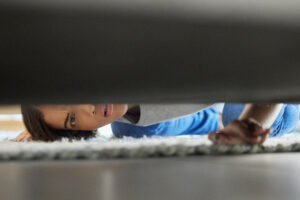What is a disorganized attachment style?
Disorganized attachment, also known as fearful-avoidant, is the rarest of all styles, as only around 5% of the population attaches this way. This insecure attachment style mixes anxious and avoidant attachments with unique traits.
Where an anxious attachment style tends to stay anxious and desperately pull closer to people to gain love, and an avoidant attachment style tends to pull away to self-preserve their emotions and safety, disorganized attachment can go back and forth between these two polar opposite points.
As the last part of this 4-part series, this article covers how this attachment style is created in childhood, the signs and traits of this style, fundamental fears, how this style affects relationships, how to move toward secure attachment, and more.
How is a disorganized attachment style created?
If you experience a disorganized attachment style, you may have grown up in a chaotic or abusive environment where your primary caregivers are the source of comfort and fear. This inconsistency can lead to you (as a child) feeling confused and afraid of your caregivers. This results in trust issues and an inability to rely on others.
According to the Attachment Theory, a caregiver’s responses to a child’s needs and emotions significantly shape attachment patterns. In the case of disorganized attachment, caregivers may act in frightening, emotionally unavailable, or inconsistent ways, leading you (as a child) to feel unsafe and unsure of how to act.
For instance, a caregiver may comfort a crying child one moment and then lash out at them the next, resulting in a mix of anxiety and confusion in the child. This inconsistent behavior creates emotional turmoil and can lead to the development of a disorganized attachment style.
A hallmark of disorganized attachment in childhood is the presence of contradictory behaviors in the child.
For example, a child with disorganized attachment may approach their caregiver for comfort, then quickly withdraw or turn away from them, as if realizing that the source of comfort is also the source of fear. This ambivalence is characteristic of disorganized attachment and serves as a defense mechanism to cope with the caregiver’s unpredictable behavior.
It is important to note that children who develop a disorganized style can still form healthy attachments later in life through intervention and support.
Understanding your childhood trauma’s impact on attachment patterns is crucial in helping you overcome these challenges and develop a secure attachment style. With proper guidance and support, you can learn to trust and form healthy relationships, despite your challenging early experiences.

Signs of a disorganized attachment style
This style includes characteristic signs and behaviors that can help identify this pattern of attachment.
Signs of disorganized attachment include:
- an inability to be comforted
- avoidance of physical contact
- difficulty building trusting relationships
- unpredictable behavior towards others (including sudden shifts between intense anger and deep sadness)
- ambivalence in close relationships
- trouble regulating emotions
- difficulty problem-solving in stressful situations
- fear of abandonment or rejection by loved ones
- difficulty forming lasting bonds with people you care about
- feeling like you are “on the outside” looking in at their lives
If you experience this attachment style, you may also engage in self-destructive behavior such as excessive drinking or substance abuse. This type of attachment may also display extreme aggression towards yourself or those around you as a defense against emotional pain.
Fundamental fears of disorganized attachment style
There are fundamental fears that stem from your early experiences of inconsistent and sometimes frightening caregiving. These fears can manifest in various ways, from difficulty forming close relationships to persistent anxiety and self-destructive behaviors.
Here are 3 of the main fears associated with disorganized attachment:
The fear of being rejected or abandoned by those you care about.
This fear is often so pervasive and intense that it can lead to pushing people away, avoiding intimate relationships, and even self-sabotaging your current relationships. The fear of rejection can increase in romantic relationships, with higher risks of vulnerability and emotional intimacy.
The fear of losing control.
You may feel overwhelmed by your emotions and struggle to regulate them effectively. This lack of control can be distressing and lead to further avoidance of close relationships or feelings of shame and self-loathing.
The fear of losing control is linked to being emotionally vulnerable. You may feel that being open and honest about your emotions puts you at risk of being hurt or rejected.
The fear of intimacy.
This fear can manifest in various ways, from difficulty forming close bonds with others to a reluctance to engage in physical touch or intimacy. You may feel that intimacy is unsafe or threatening resulting in the avoidance of it at all costs. This fear can be particularly challenging in dating or marriage, where intimacy is often seen as a central component of a healthy

Disorganized attachment style in relationships
A disorganized attachment style can profoundly impact adult friendships and relationships. You may struggle to establish and maintain healthy connections with others with this attachment style. You may also experience intense emotional turmoil as a result.
For example, It may be difficult to trust others or rely on them for emotional support when it comes to adult friendships.
There is a fear that others will reject or abandon you. Or you could struggle to regulate your emotions in a way that allows you to maintain close connections. This fear of rejection can lead to a pattern of short-lived or turbulent friendships and feelings of loneliness, isolation, and despair.
In romantic relationships, disorganized attachment can be even more challenging. You may struggle to establish intimacy or to feel comfortable sharing your feelings with your partner. You may also feel overwhelmed by strong emotions, leading to intense arguments or unpredictable mood swings. In some cases, disorganized attachment can even lead to abusive or toxic relationship dynamics, as the intense feelings could lead to aggression or manipulation to maintain control.
Moving toward a secure attachment style
While disorganized attachment can be challenging to overcome, working toward secure attachment is possible. Here are some strategies you can use to improve your symptoms and develop healthier relationships. It is worth noting that these strategies can be helpful for every attachment type, even a secure one.
Seek therapy
One of the most effective ways to address disorganized attachment is through online therapy. Online therapy with Makin Wellness can help you identify the root causes of your attachment style and develop strategies for regulating emotions, improving communication, and building healthier relationships.
Practice mindfulness
Mindfulness can be a powerful tool when working through your fears. Mindfulness helps with increasing emotional awareness and your ability to manage them. Mindfulness practices, such as breathing exercises and meditation, can be helpful in reducing anxiety and improving mood as well.
Develop self-compassion
Since there are some significant fears you may be wrestling with, you may also be coping with self-criticism and shame. Developing self-compassion can help you overcome unhelpful and skewed self-beliefs.
Build healthy relationships
One of the best ways to develop a more secure attachment style is to cultivate and maintain healthy relationships. By seeking out supportive friends and partners, you can create a sense of safety, trust, and emotional connection that you may have lacked in childhood.
Building healthy relationships also involves setting boundaries, expressing needs and emotions, and learning to communicate effectively. These all can be part of your personalized treatment plan during your online therapy sessions.
Practice self-reflection
Practicing self-reflection allows you to gain a deeper understanding of your emotions, beliefs, and behaviors that contribute to unhealthy attachments.
Reflecting on your childhood experiences and how they have affected your adult life can offer incredible insight into where you came from and how far you’ve come.This understanding is pivotal when making the positive changes necessary that lead to a more secure attachment style.
If you experience disorganized attachment, you can improve your symptoms, build healthier relationships, and live a more fulfilled life by taking these steps and putting them into action.

Why understanding the attachment style of others can be beneficial
Understanding each attachment style can help you when seeking to support and care for someone with secure, anxious, avoidant, or disorganized attachment styles. Knowing what may trigger a person’s traumas or behaviors and how to respond in a supportive way can make a tremendous difference in how they interact with all of their relationships.
Just like understanding your partner’s preferred love language – how they prefer to give and receive love – knowing their attachment style can greatly impact how you care for your partner.
With awareness, patience, and empathy, you can care for yourself and others in a more intentional, healthy way.
Conclusion to the Attachment Style Series
While it is essential to understand the nuances of each attachment style, it is equally important to remember that behavior isn’t permanent – you have the power to change your outlook and improve your relationships.
With awareness, effort, and time, you can build healthier attachments. Building self-esteem, setting healthy boundaries, and becoming aware of your emotional triggers can create a secure attachment with yourself and others.
Secure attachment is something everyone deserves. It starts by creating self-awareness about your behaviors and those you want to be closer to.
If you have questions and want to learn how to create healthier relationships and form a more secure attachment style, Makin Wellness can help. By speaking to one of our online therapists, you will have a personalized treatment plan catered to your goals. Call us at (833)-274-heal or make an appointment to connect with an online therapist who is trained to help you where you’re at and guide you through the process of healing.








